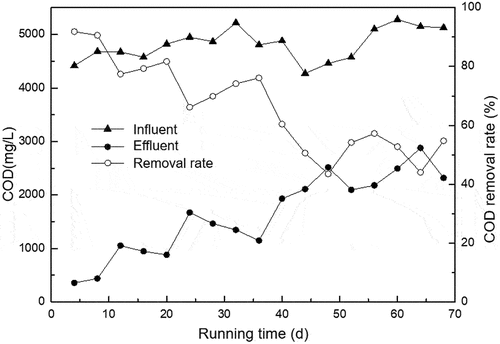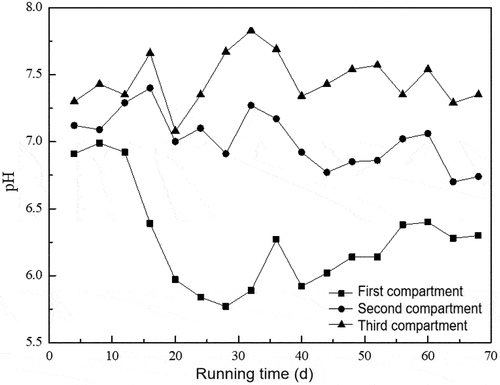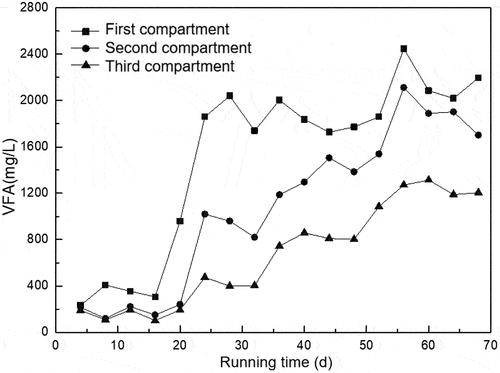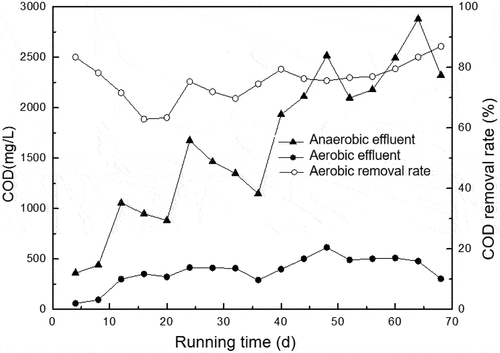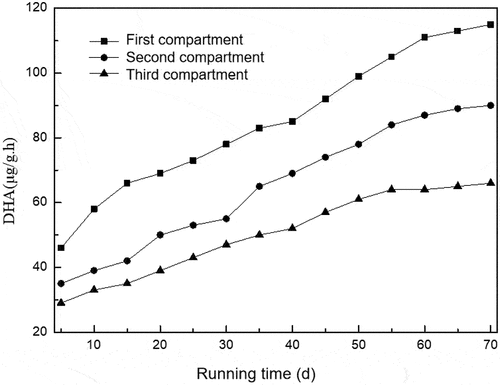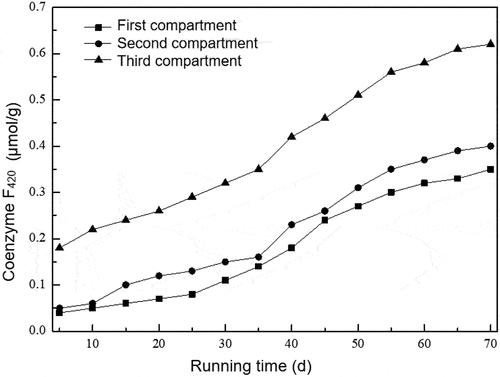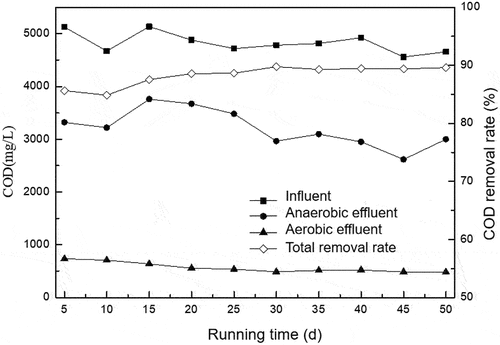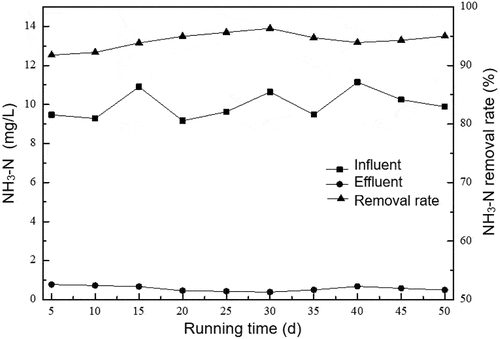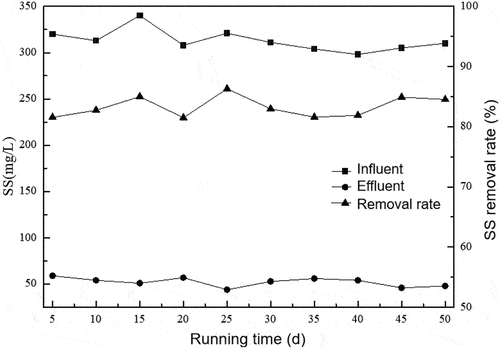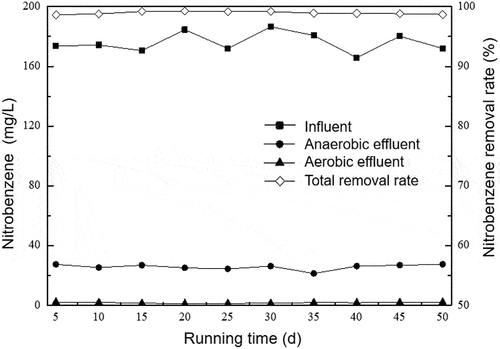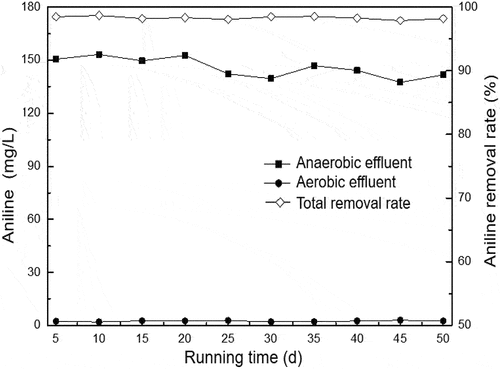ABSTRACT
In this work, a new type of integrated anaerobic aerobic bioreactor (IAAB) was formed by optimizing the structure of the anaerobic baffle bioreactor and aerobic biological contact oxidation pool. IAAB was used to treat the production wastewater of a chemical plant. The whole process was divided into two stages of domestication and stable operation. With increasing the proportion of chemical wastewater, the total amount of extracellular polymeric substances increased, and the ratio of protein to polysaccharide decreased. Dehydrogenase activity of anaerobic granular sludge in each compartment increased about 1.5 times with time, and decreased about 42% along the flow direction from the first compartment to the third compartment. The coenzyme F420 increased about 4 times with time, and increased about 1.2 times along the flow direction. The IAAB showed excellent removal rate of chemical oxygen demand (85%), ammonia nitrogen (94%), nitrobenzenes (98%).
1. Introduction
With the development of social economy and industrial production, environmental problems, especially water pollution, are becoming very serious [Citation1,Citation2]. Chemical wastewater is the wastewater discharged from the production process of a certain chemical product including process wastewater, cooling water, waste gas washing water, equipment and site washing water. There are many toxic and harmful substances in chemical wastewater, such as nitro compounds, halogen compounds, cyclic aromatic hydrocarbons and aromatic amines, and heavy metals, such as lead, cadmium and mercury. As a large amount of untreated and substandard wastewater is discharged into natural water, it causes serious pollution to water resources [Citation3–5].
The water quality composition of chemical wastewater is more complex, the water quality and quantity of the wastewater are unstable, the BOD5/COD ratio is low, and the biodegradability is poor, so the treatment of chemical wastewater is difficult. Chemical wastewater treatment methods include physical method, chemical method, physical chemical method and biological method. However, most of the wastewater treatment processes were separated to each treatment unit, and sometimes the sludge reflux and wastewater recycling must be carried out. For the high concentration wastewater, the treatment process not only increases the investment cost but also is difficult to meet the discharge standards [Citation6]. Therefore, the research and development of high efficiency and low cost of wastewater treatment technology has become an important topic.
The integrated bioreactor integrates reaction, sedimentation and sludge reflux, which greatly reduces the floor area, improves the load capacity of the bioreactor, and enhances the removal of nitrogen and phosphorus [Citation7–10]. Early integrated bioreactors combined aeration and precipitation or adjusted the time sequence of aeration and precipitation. In order to achieve the removal of nitrogen and phosphorus at the same time, the integrated bioreactor began to combine anaerobic and aerobic to form a variety of efficient integrated bioreactors, which included two anaerobic compartments and two aerobic compartments in sequence [Citation11,Citation12]. The chemical oxygen demand (COD), NH4+–N and total nitrogen (TN) were successfully removed with the average removal of 86.8%, 100% and 91.3%, respectively [Citation11]. The anaerobic process converts organic contaminants into methane, CO2, and H2O in the absence of oxygen, while the aerobic process uses free or dissolved oxygen to degrade the organic and other contaminants. The combined anaerobic–aerobic system is easy to operate, consumes less energy (about 20%), exhibits high pollutants removal efficiency (about 25%), produces less secondary sludge and cost effective [Citation13,Citation14], [Citation9,Citation15]; [Citation16]; [Citation17]; [Citation18]; [Citation19]; [Citation20].
In this work, a new type of integrated anaerobic aerobic bioreactor (IAAB) was formed by optimizing the structure of anaerobic baffle bioreactor and aerobic biological contact oxidation pool. IAAB was used to treat the production wastewater of a chemical plant. The concentration of COD in influent water was fixed, the proportion of glucose was gradually reduced, and the proportion of chemical wastewater was increased in the treatment process. The whole process was divided into two stages of domestication and stable operation. The changes of COD, VFA and pH as well as EPS, DHA and F420 in anaerobic chamber were investigated during domestication stage. F420 and DHA were mainly used to investigate the changes in the activity of microorganisms in the reactor during the domestication stage and the stable stage, which reflected the changes of microorganisms in the face of treatment load, and also reflected the biological treatment status of the reactor. The bioreactor is suitable for treating chemical wastewater only when the microorganisms are in the adaptive stage. COD removal in anaerobic chamber and aerobic chamber and the removal of ammonia nitrogen, SS, and nitrobenzenes were also investigated during the stable operation stage. During stable operation, effluent COD is stable at less than 500 mg/L, the total COD removal rate is stable between 84% and 89%, and effluent ammonia nitrogen and SS concentrations are about 0.5 mg/L and 50 mg/L, respectively, which can meet the takeover standards of the local wastewater treatment plant (the chemical wastewater from chemical enterprises is discharged into the centralized sewage treatment plant in the industrial park for further treatment to meet the discharge standard of Jiangsu Province (DB32/939–2020)).
2. Materials and methods
2.1. Bioreactor design and set-up
The basic configuration of the IAAB was a bioreactor configuration with different compartments. The first, second, third, and last compartment of this pilot-scale bioreactor were designed for heating (36 L), anaerobic process (36 L), aerobic process (55.2 L), and settlement (37 L), respectively. The specific configuration can be seen from our previous report [Citation21]. As shown in , the heating compartment was equipped with a heater and a stirrer to keep the influent homogeneous with temperature of around 35°C. The second compartment for anaerobic process was an anaerobic baffled reactor (ABR), which contained two vertical standing baffles to divide the compartment into three identical sections (Sect.1, Sect.2, and Sect.3). Within each section, down comer and riser regions were created using a slanted edge (45°) vertical baffle. This design can direct the flow evenly through the riser. Each section of ABR was also equipped with sampling ports that allowed the withdrawal of solid and liquid samples. The compartment for aerobic process was designed as the biological contact oxidation pond (BCO) with lots of inner packing made from filaments of polymer and aldehyde. The final compartment was designed as the settlement zone with a returnable activated sludge system for returning bio-solids back to the aerobic compartment.
Figure 1. Schematic diagram of the IAAB process [Citation21]: 1, feed tank; 2, peristaltic pump; 3, heater; 4, supernatant sampling port; 5, sludge sampling port; 6, gas collection; 7, reflux pump; 8, aeration pump; 9, effluent.
![Figure 1. Schematic diagram of the IAAB process [Citation21]: 1, feed tank; 2, peristaltic pump; 3, heater; 4, supernatant sampling port; 5, sludge sampling port; 6, gas collection; 7, reflux pump; 8, aeration pump; 9, effluent.](/cms/asset/7be0a18f-f567-4a89-9220-65624baf2f14/tcsb_a_2327359_f0001_b.gif)
2.2. Wastewater composition
The experimental water was the production wastewater of a chemical plant, which contained a large number of toxic substances that were difficult to degrade. If the chemical wastewater was directly used, it would not be conducive to the domestication of sludge in IAAB. Therefore, the asynchronous domestication method was adopted. Glucose was used as the co-metabolic substrate, NH4Cl and KH2PO4 were added to supplement the nitrogen and phosphorus required for bacterial growth. COD:N:P was controlled at 200:5:1, a certain trace element was added, and NaHCO3 was added to maintain the influent pH between 6.8 and 7.2. The composition of wastewater is as follows: COD 4000–5000 mg/L,BOD5 2000–3000 mg/L,NH3-N 10–15 mg/L,TN 30–40 mg/L,sulfate 1000 mg/L, TP 0.3–0.5 mg/L,SS 300–350 mg/L,pH 8 – 9,volatile phenol 0.3–0.4 mg/L,chroma 100–150 times,nitrobenzenes 170–190 mg/L.
2.3. Mode of operation
This operation is divided into two stages. The first stage is the domestication stage, where influent COD is about 5000 mg/L and hydraulic retention time (HRT) is 48 h, and the proportion of glucose and wastewater is gradually adjusted. The operation conditions are shown in . The composition of chemical wastewater is complex, and there is an adaptation process for anaerobic and aerobic microorganisms in the reactor. The purpose of the domestication stage is to make the microorganisms in the reactor sludge have a time stage to adapt to the efficient treatment of chemical wastewater. The second stage is the stable operation, which takes chemical wastewater as the influent water and keeps the HRT for 48 h. The parameters analyzed during the operations include COD, VFA, pH, EPS, DHA, F420, SS, ammonia nitrogen, nitrobenzene and aniline.
Table 1. Operation conditions of IAAB.
2.4. Sample analysis
Water quality of the effluent from the IAAB was monitored during the experiment. COD, SS and ammonium nitrogen (NH3-N) concentrations of the samples were measured according to the Standard Methods [Citation22]. pH was measured by a PHS-25 digital pH meter. The volatile fatty acids (VFAs) were measured using the titrimetric method [Citation23]. EPS was extracted from microbial floc through heat treatment [Citation24]. The extracted solution was analyzed for total carbohydrate and proteins. The carbohydrates in EPS were determined using the phenol-sulfuric acid method, with glucose as a standard. The proteins in EPS were determined using Folin method, with bovine serum albumin as a standard [Citation25]. The dehydrogenase activity (DHA) and coenzyme F420 contents were used to determine the microbial activity of anaerobic sludge. DHA was measured according to the proposed method by Zhang et al. [Citation26]. The method for determining coenzyme F420 of the sludge was the same as reported by Janga et al. [Citation27]. Nitrobenzene and aniline concentrations were determined by Agilent 1100 HPLC with C-18 reverse column.
3. Results and discussion
3.1. Removal of COD in anaerobic chamber during the domestication stage
The removal of organic matter in sewage biological treatment bioreactor is an important indicator to evaluate the performance of the bioreactor. COD is a common index to characterize the organic matter content in sewage water. During the domestication stage, HRT is fixed to 48 h, influent COD concentration is about 5000 mg/L. The dosage of glucose is gradually reduced with a increase in the proportion of chemical wastewater until the influent water is all the chemical wastewater.
During the domestication stage, the changes of COD in anaerobic chamber are shown in . As can be seen from the figure, the COD removal rate generally presents a downward trend. In the early stage of domestication, the COD removal rate was high (about 90%). It mainly because after 96 days of IAAB start-up, most of the sludge in anaerobic chamber was granalized, which had a certain load resistance capacity. From the 6d, the COD concentration of the effluent in anaerobic chamber began to rise, and the removal rate continued to decline. It mainly because some microorganisms were not adapt to the wastewater environment, which resulted in bacterial autolysis and the release of intracellular substances into the bioreactor. This bacterial autolysis phenomenon often occurs in domestication of complex, highly toxic or with high load wastewater. In the process of domestication, a large number of microorganisms die and autolysis which are caused by the continuous addition of wastewater. Bacterial autolysis leads to a decrease in the number of effective microorganisms involved in wastewater treatment, manifested as a decrease in MLVSS. With the process of domestication, microorganisms will gradually adapt to the environment, and the COD removal rate will gradually increase. Therefore, after each addition of wastewater, the COD removal rate in anaerobic chamber was increased. Ghaniyari et al. [Citation28] have used ABR treating synthetic wastewater. They concluded that long-term operation and an increase in influent COD concentration make anaerobic process form phase separation (e.g. into acidogenesis phase and methanogenesis phase) by high activity of hydrolytic and acidogenic bacteria as compared to methanogenic bacteria. Baloch et al. [Citation29] have found that hydrolysis and acidogenesis are the main biochemical activities occurring in the first few sections, and methanogenesis is the main biochemical activities occurring in the last few sections.
3.2. Change of pH in anaerobic chamber during the domestication stage
pH is critical for anaerobic biological treatment of wastewater. In general, the suitable pH for most methanogenic microorganisms was between 6.8 and 7.2 [Citation5], especially for methanogens. Outside this range, methanogens in anaerobic processes are partially inhibited, and the entire anaerobic digestion process will be adversely affected. For acidogenic bacteria and other anaerobic bacteria, the optimal pH value is higher between 7 and 7.5. Therefore, it is very important to measure and adjust the pH value of the system regularly.
The test water is a chemical plant production wastewater, the pH value is between 8 and 9. Thus, hydrochloric acid was used to adjust the influent pH value between 6.8 and 7.2. shows the change of pH value in each chamber of anaerobic chamber. From the results of the whole domestication process, we can see that after each addition of the chemical wastewater, the pH value of the effluent decreases, and the fluctuation is obvious. After running for a period of time, the pH value begins to rise slowly. The first compartment is the most impacted by the load, the pH value fluctuates greatly, and is often reduced to below 6.0, which has the tendency of acidification. The pH value of each compartment showed an upward trend, and the pH value of the third compartment was the highest, ranging from 7.3 to 7.6.
3.3. Change of VFA in anaerobic chamber during the domestication stage
The appropriate concentration of VFA in the anaerobic digestion tank was lower than 2000 mg/L, and for the high-efficiency anaerobic bioreactor, better treatment efficiency could be obtained when the concentration of VFA was lower than 200 mg/L. In general, the higher treatment efficiency and the stronger buffer capacity of the bioreactor, the higher concentration of VFA could be allowed. However, if the concentration of VFA in effluent is too high, serious acidification will occur inside the bioreactor, which will affect the normal operation of the whole system.
shows the change of VFA during the domestication stage in each compartment. As can be seen from the figure, the concentration of VFA in each compartment was low, and the difference was small in the early stage of domestication. It was mainly due to the initial glucose activate in anaerobic chamber, which caused a large number of methanogens to grow and multiply, and degraded VFA in each compartment. The first compartment is the anaerobic baffle reactor. Anaerobic sludge is added to the first compartment, and in the process of operation, there is no oxygen supply, it is under a relatively strict anaerobic environment. Therefore, the dominant bacteria in the first compartment are anaerobic microorganisms. However, methanogens were the dominant bacteria in the last two compartments, resulting in a rapid decline of VFA. At the later stage of domestication, VFA concentrations in each compartment were higher, and the difference was large. It may be due to the increasing proportion of chemical wastewater inhibited methanogenic bacteria, while acidogenic bacteria proliferate. At the initial stage of each water distribution, VFA tends to rise and then begins to decline, which is due to the automatic adjustment balance of acid phase and methanogenic phase in the anaerobic fold-flow bioreactor.
3.4. Removal of COD in aerobic chamber during the domestication stage
The removal of COD in aerobic chamber during the domestication stage is shown in . As can be seen from the figure, the influent water in aerobic chamber is the influent water in anaerobic chamber. The COD concentration changes greatly and shows a rising trend in general, and the range is between 500 and 2500 mg/L. The COD concentration of the effluent in the aerobic chamber is lower than 500 mg/L, and the removal rate is 75–85%. In the early stage of domestication, the COD removal rate showed a downward trend. It may be due to the fact that some microorganisms were not adapt to the wastewater environment, resulting in the death and autolysis of a large number of microorganisms. With the continuous addition of wastewater, microorganisms began to adapt to the environment, and the COD removal rate began to rise and eventually became stable.
3.5. Change of EPS in anaerobic chamber during the domestication stage
In this work, the anaerobic sludge was obtained from the UASB process of a pharmaceutical factory in Jingjiang City, Jiangsu Province, with MLSS of 11.05 g/L, MLVSS of 7.55 g/L, MLVSS/MLSS of 0.68 and SVI of 25.34 mL/g. The aerobic sludge was obtained from the East Sewage Treatment Plant of Yancheng City, Jiangsu Province, and its MLSS was 7.16 g/L, MLVSS was 5.01 g/L, MLVSS/MLSS was 0.70, and SVI was 116.68 mL/g. The percentage of granules in different size was determined by calculating the ratio between the weight of the granules in a range of size and the weight of granules in all sizes. The size of most granules ranged between 0.5 and 4 mm. About 84.1%, 81.2% and 79.7% (on weight basis, w/w) of the granules from each section were larger than 0.5 mm.
EPS primarily includes polysaccharides and proteins, which assist in the formation of microbial granules [Citation30]. The change of EPS in anaerobic chamber during the domestication stage is shown in . In the process of domestication, with increasing the proportion of influent chemical wastewater, EPS increased, especially the polysaccharide content in EPS, resulting in a continuous decline in the ratio of protein to polysaccharide. This may be due to the fact that the microorganisms in the bioreactor have not adapted to the environment and could not exhaust all the carbon sources, which will accumulate on the surface of the sludge as EPS. Wang et al. [Citation31] found that the surface properties of sludge depended more on the ratio of protein to polysaccharide than on the total amount of EPS. The mature granular sludge with high-efficiency rate has a high protein to polysaccharide ratio, which reveals poor settleability [Citation32,Citation33]. The ratio of protein to polysaccharide was positively correlated with hydrophobicity and negatively correlated with surface load. These indicate that in the process of increasing the proportion of chemical wastewater, the decrease of protein content and the increase of polysaccharide content will reduce the hydrophobicity of the sludge surface, and then affect the structural stability of anaerobic granular sludge.
Table 2. EPS content in sludge of anaerobic chamber.
3.6. Changes of DHA in anaerobic chamber during the domestication stage
The biological sewage treatment is a reactive process that is promoted by enzymes. The dehydrogenation is the key approach of the biochemical reaction, so DHA can be considered as a great indicator of the active fraction of anaerobic sludge [Citation34]. The changes of microbial DHA in each compartment of the anaerobic chamber during the domestication stage are shown in . At the early stage of domestication, the DHA concentration of granular sludge in each compartment was relatively low. It may be due to the addition of chemical wastewater that made the organisms in the bioreactor unable to adapt to the environment, and their dehydrogenation was inhibited. With increasing proportion of chemical wastewater, microorganisms gradually adapt to the environment, and the DHA concentration of granular sludge in each compartment gradually increases with time. The DHA concentration in the first compartment was higher than those in the other compartments and decreased along the flow direction, indicating that most of the substrate was dehydrogenated in the front compartment to participate in acid fermentation, and the acid fermentation began to weaken along the flow direction. Reports suggested that in the process of biochemical degradation, aerobic microorganisms have dehydrogenation [Citation34].
3.7. Changes of F420 in anaerobic chamber during the domestication stage
The changes of microbial coenzyme F420 in each compartment of the anaerobic chamber during the domestication stage are shown in . At the early stage of the domestication, the concentration of coenzyme F420 in granular sludge in each compartment was relatively low. It may be due to the addition of chemical wastewater that made the organisms in the bioreactor unable to adapt to the environment, and their methanogenic activity was inhibited. With the continuous domestication, microorganisms would gradually adapt to the environment. The concentration of coenzyme F420 in granular sludge in each compartment showed a gradual increasing trend over time, which was similar to that of DHA. However, the concentration of coenzyme F420 in the third compartment was higher than that in other compartments, indicating that the metabolic substrate produced by acidic fermentation in the front compartment entered the back compartment and further participated in alkaline fermentation. The alkaline fermentation of the back compartment was gradually enhanced.
3.8. Removal of COD and ammonia nitrogen during stable operation
shows the changes of COD in IAAB during stable operation. As can be seen from the figure, the COD concentration of influent is maintained at about 5000 mg/L, the effluent of anaerobic chamber is stable between 3000 and 3600 mg/L, and the effluent of aerobic chamber is maintained at about 500 mg/L, and the total COD removal rate is stable between 84% and 89%. This indicates that the system has reached a stable state, and the bacteria in IAAB have basically adapted to the wastewater environment, and the bacteria are no longer autolysis.
shows the removal of ammonia nitrogen of the system in the stable operation stage. As can be seen from the figure, the influent ammonia nitrogen concentration is maintained at about 10 mg/L, the effluent ammonia nitrogen is stable between 0.4 and 0.6 mg/L, and the average removal rate of ammonia nitrogen is stable at about 95%, indicating that the system has a good ability to remove ammonia nitrogen. Similar results have been reported [Citation35,Citation36], the COD and NH3-N results confirmed that the integrated anaerobic–aerobic bioreactor is a suitable technology for the treatment of high-strength wastewaters (COD > 5000 mg/L).
3.9. Removal of SS during stable operation
shows the changes of SS in the stable operation stage. As can be seen from the figure, the SS concentration in the effluent is relatively stable, about 50 mg/L, and the SS removal rate is between 81% and 84%, which indicates that the system has a good SS interception effect. This may be due to the unique chamber structure of anaerobic chamber, where the baffle forces the water to flow up and down, so that the wastewater is in full contact with anaerobic organisms. A large number of suspended solids are effectively removed in anaerobic chamber, and the remaining suspended solids are effectively intercepted when passing through the combined filler of aerobic chamber.
3.10. Removal of nitrobenzene and aniline
shows the removal of nitrobenzene in the stable operation stage. As can be seen from the figure, the influent nitrobenzene concentration is stable in the range of 170–190 mg/L, after anaerobic treatment, the effluent nitrobenzene concentration decreased to 21.46–27.56 mg/L, and then after aerobic treatment, the effluent nitrobenzene concentration decreased to 1.35–2.33 mg/L. The average removal rate of nitrobenzene by IAAB system is about 98%, and the concentration of nitrobenzene in effluent can meet the national secondary emission standard.
shows the removal of aniline in the system. The concentrations of aniline in the effluent of anaerobic chamber and aerobic chamber were 139.54–152.68 mg/L and 2.04–2.93 mg/L, respectively. The average removal rate of aniline in aerobic chamber was about 97%, indicating that most nitrobenzene compounds in the effluent were converted to aniline under anaerobic conditions with an average conversion rate of 87.5%. Then, most aniline can be further degraded under aerobic conditions. Under anaerobic conditions, nitrobenzene can be reduced to aniline through a series of electron gain and loss and protonation, while anilines are easy to open the ring by mono-oxygenase or di-oxygenase under aerobic conditions, and finally mineralized [Citation37]. The test results show that the integrated reaction system can effectively eliminate high-concentration nitrobenzene wastewater [Citation38–40].
4. Conclusion
In this work, IAAB was used to treat the production wastewater of a chemical plant. The domestication time is 68 days, the influent COD concentration is 4500–5000 mg/L, and the HRT of anaerobic chamber is 48 h. In the early stage of domestication, some microorganisms in IAAB system could not adapt to the chemical wastewater, resulting in bacterial autolysis. As a result, the COD removal rate and the pH value continued to decline, the VFA in anaerobic chamber continued to rise. In the later period of domestication, microorganisms began to adapt to the environment gradually, and various indexes were improved.
The biological indexes of anaerobic granular sludge in each compartment of anaerobic chamber were changed. With increasing the proportion of chemical wastewater, the total amount of EPS is increasing, while the ratio of protein to polysaccharide is decreasing. DHA activity of anaerobic granular sludge in each compartment increased with time and decreased along the flow direction. The activity of coenzyme F420 increased gradually along the flow direction.
During stable operation, the effluent COD is stable at about 500 mg/L, the total removal rate is stable between 84% and 89%. The effluent ammonia nitrogen and SS concentrations are about 0.5 mg/L and 50 mg/L, respectively, and the average removal rate is 94% and 83%, respectively. The concentration of nitrobenzene in effluent is between 1.35 and 2.33 mg/L, and the average removal rate of nitrobenzene is about 98%. The concentrations of aniline in the effluent of anaerobic chamber and aerobic chamber are 139.54 to 152.68 mg/L and 2.04 to 2.93 mg/L, respectively, and the average removal rate of aniline in aerobic chamber can reach 97%.
Disclosure statement
No potential conflict of interest was reported by the author(s).
Data availability statement
Data will be made available on request.
Additional information
Funding
References
- Kellis M, Kalavrouziotis IK, Gikas P. Review of wastewater reuse in the Mediterranean countries, focusing on regulations and policies for municipal and industrial applications. Global Nest J. 2013;15(3):333–224.
- Partyka ML, Bond RF. Wastewater reuse for irrigation of produce: a review of research, regulations, and risks. Sci Total Environ. 2022;828:154385. doi: 10.1016/j.scitotenv.2022.154385
- Zhang W, Liu F, Wang D, et al. Impact of bioreactor configuration on treatment performance and microbial diversity in treating high-strength dyeing wastewater: anaerobic flat-sheet ceramic membrane bioreactor versus upflow anaerobic sludge blanket bioreactor. Biores Technol. 2018;269:269–275. doi: 10.1016/j.biortech.2018.08.126
- Show KY, Ling M, Guo H, et al. Laboratory and full-scale performance of integrated anaerobic granule-aerobic biofilm-activated sludge processes for high strength recalcitrant paint wastewater. Biores Technol. 2020;310:123376. doi: 10.1016/j.biortech.2020.123376
- Show KY, Yan YG, Lee DJ, et al. Green technologies for industrial wastewater treatment – sustainable attributes and prospects of anaerobic granulation. Green Technologies For Sustainable Water Management, ASCE, Chapter. 2016;7:231–254.
- El-Kamah H, Tawfik A, Mahmoud M, et al. Treatment of high strength wastewater from fruit juice industry using integrated anaerobic/aerobic system. Desalination. 2010;253(1):158–163. doi: 10.1016/j.desal.2009.11.013
- Foco MLR, Batista VM, Candello FP, et al. Degradation of formaldehyde treated in conjunction with municipal sewage in combined anaerobic-aerobic system. Engenharia Sanitaria E Ambiental. 2015;20(1):103–110. doi: 10.1590/S1413-41522015020000129576
- Kassab G, Halalsheh M, Klapwijk A, et al. Sequential anaerobic-aerobic treatment for domestic wastewater - A review. Biores Technol. 2010;101(10):3299–3310. doi: 10.1016/j.biortech.2009.12.039
- Ma K, Li X, Bao L, et al. The performance and bacterial community shifts in an anaerobic-aerobic process treating purified terephthalic acid wastewater under influent composition variations and ambient temperatures. J Clean Prod. 2020;276:124190. doi: 10.1016/j.jclepro.2020.124190
- Zhao J, Dong X, Su H, et al. Rapid start-up of PN/A process and efficient enrichment of functional bacteria: A novel aerobic-biofilm/anaerobic-granular nitrogen removal system (OANRS). Biores Technol. 2023;380:128944. doi: 10.1016/j.biortech.2023.128944
- Deng K, Tang L, Li J, et al. Practicing anammox in a novel hybrid anaerobic-aerobic baffled bioreactor for treating high-strength ammonium piggery wastewater with low COD/TN ratio. Biores Technol. 2019;294:122193. doi: 10.1016/j.biortech.2019.122193
- Farid MAA, Zakaria MR, Hassan MA, et al. A holistic treatment system for palm oil mill effluent by incorporating the anaerobic–aerobic–wetland sequential system and a convective sludge dryer. Chem Eng J. 2019;369:195–204. doi: 10.1016/j.cej.2019.03.033
- Liu J, Tian C, Jia X, et al. The brewery wastewater treatment and membrane fouling mitigation strategies in anaerobic baffled anaerobic/aerobic membrane bioreactor. Biochem Eng J. 2017a;127:53–59. doi: 10.1016/j.bej.2017.07.009
- Shoukat R, Khan SJ, Jamal Y. Hybrid anaerobic–aerobic biological treatment for real textile wastewater. Water Proc Eng. 2019;29:100804. doi: 10.1016/j.jwpe.2019.100804
- Ashfaq M, Li Y, Wang Y, et al. Occurrence, fate, and mass balance of different classes of pharmaceuticals and personal care products in an anaerobic–anoxic-oxic wastewater treatment plant in Xiamen, China. Water Res. 2017;123:655–667. doi: 10.1016/j.watres.2017.07.014
- Costa AM, Alfaia RGSM, Campos JC. Landfill leachate treatment in Brazil – an overview. J Environ Manage. 2019;232:110–116. doi: 10.1016/j.jenvman.2018.11.006
- El–Senousy WM, Abou–Elela SI. Assessment and evaluation of an integrated hybrid anaerobic–aerobic sewage treatment system for the removal of enteric viruses. Food Environ Virol. 2017;9(3):287–303. doi: 10.1007/s12560-017-9286-4
- Hameed BB, Ismail ZZ. Biodegradation of reactive yellow dye using mixed cells immobilized in different biocarriers by sequential anaerobic/aerobic biotreatment: experimental and modeling study. Environ Technol. 2020;42(19):2991–3010. doi: 10.1080/09593330.2020.1720306
- Jayapal M, Jagadeesan H, Shanmugam M, et al. Sequential anaerobic–aerobic treatment using plant microbe integrated system for degradation of azo dyes and their aromatic amines by–products. J Hazard Mater. 2010;354:231–243. doi: 10.1016/j.jhazmat.2018.04.050
- Li Y, Tang F, Xu D, et al. Advances in biological nitrogen removal of landfill leachate. Sustainability. 2021;13(11):6236. doi: 10.3390/su13116236
- Jin J, Wang Q, Yang L, et al. Pilot-scale integrated anaerobic–aerobic bioreactor for COD and NH3-N removal: start-up, key processes, and performance. Water Air Soil Pollut. 2023;234(8):530. doi: 10.1007/s11270-023-06545-9
- APHA. Standard methods for the examination of water and wastewater. 21st ed. Washington (DC): American Public Health Association (APHA); 2005.
- Dong F, Zhao QB, Li WW, et al. Novel online monitoring and alert system for anaerobic digestion reactors. Environ Sci Technol. 2011;45(20):9093–9100. doi: 10.1021/es202245f
- Adav SS, Lee DJ. Extraction of extracellular polymeric substances from aerobic granule with compact interior structure. J Hazard Mater. 2008;154(1–3):1120–1126. doi: 10.1016/j.jhazmat.2007.11.058
- Ahn Y, Kang S, Chae S, et al. Simultaneous high-strength organic and nitrogen removal with combined anaerobic up-flow bed filter and aerobic membrane bioreactor. Desalination. 2007;202(1):114–121. doi: 10.1016/j.desal.2005.12.046
- Zhang LG, Yin J, Liu L. Characterization of metabolic activities of waste-activated sludge from the SBR process. J Environ SciHealth A. 2009;44(8):752–757. doi: 10.1080/10934520902928255
- Janga N, Ren X, Kim G, et al. Characteristics of soluble microbial products and extracellular polymeric substances in the membrane bioreactor for water reuse. Desalination. 2007;202(1–3):90–98. doi: 10.1016/j.desal.2005.12.043
- Ghaniyari-Benis S, Martín A, Borja R. Kinetic modelling and performance prediction of a hybrid anaerobic baffled reactor treating synthetic wastewater at mesophilic temperature. Process Biochem. 2010;45(10):1616–1623. doi: 10.1016/j.procbio.2010.06.016
- Baloch MI, Akunna JC. Granular bed baffled reactor (grabbr): solution to a two-phase anaerobic digestion system. J Environ Eng. 2003;129(11):1015–1021. doi: 10.1061/(ASCE)0733-9372(2003)129:11(1015)
- Jin RC, Yu JJ, Ma C, et al. Performance and robustness of an ANAMMOX anaerobic baffled reactor subjected to transient shock loads. Biores Technol. 2012;114:126–136. doi: 10.1016/j.biortech.2012.03.019
- Wang ZP, Liu LL, Yao J, et al. Effects of extracellular polymeric substances on aerobic granulation in sequencing batch bioreactors. Chemosphere. 2006;63(10):1728–1735. doi: 10.1016/j.chemosphere.2005.09.018
- Ma Y, Hira D, Li Z, et al. Nitrogen removal performance of a hybrid anammox reactor. Biores Technol. 2011;102(12):6650–6656. doi: 10.1016/j.biortech.2011.03.081
- Tang CJ, Zheng P, Wang CH, et al. Performance of high-loaded ANAMMOX UASB reactors containing granular sludge. Water Res. 2011;45(1):135–144. doi: 10.1016/j.watres.2010.08.018
- Xie B, Liu H, Yan Y. Improvement of the activity of anaerobic sludge by low-intensity ultrasound. J Environ Manage. 2009;90(1):260–264. doi: 10.1016/j.jenvman.2007.09.004
- Bodkhe SY. A modified anaerobic baffled reactor for municipal wastewater treatment. J Environ Manage. 2009;90(8):2488–2493. doi: 10.1016/j.jenvman.2009.01.007
- Xiao H, Peng H, Yang P. Performance of a new-type integrated biofilm reactor in treating high concentration organic wastewater. Procedia Environ Sci. 2011;11:674–679. doi: 10.1016/j.proenv.2011.12.105
- Chen Q. Study on the combined treatment of nitrobenzene wastewater by HABR-SBR[D]. Nanjing: Nanjing University of Science and Technology; 2009.
- Liu J, Yuan Y, Li B, et al. Enhanced nitrogen and phosphorus removal from municipal wastewater in an anaerobic–aerobic–anoxic sequencing batch bioreactor with sludge fermentation products as carbon source. Biores Technol. 2017b;244:1158–1165. doi: 10.1016/j.biortech.2017.08.055
- Samsudina MH, Shirai Y, Hassan MA. A holistic treatment system for palm oil mill effluent by incorporating the anaerobic–aerobic–wetland sequential system and a convective sludge dryer. Chem Eng J. 2019;369:195–204. doi: 10.1016/j.cej.2019.03.033
- Sun Q, Li Y, Wang Y. Occurrence, fate, and mass balance of different classes of pharmaceuticals and personal care products in an anaerobic–anoxic-oxic wastewater treatment plant in Xiamen, China. Water Res. 2017;123:655–667. doi: 10.1016/j.watres.2017.07.014


